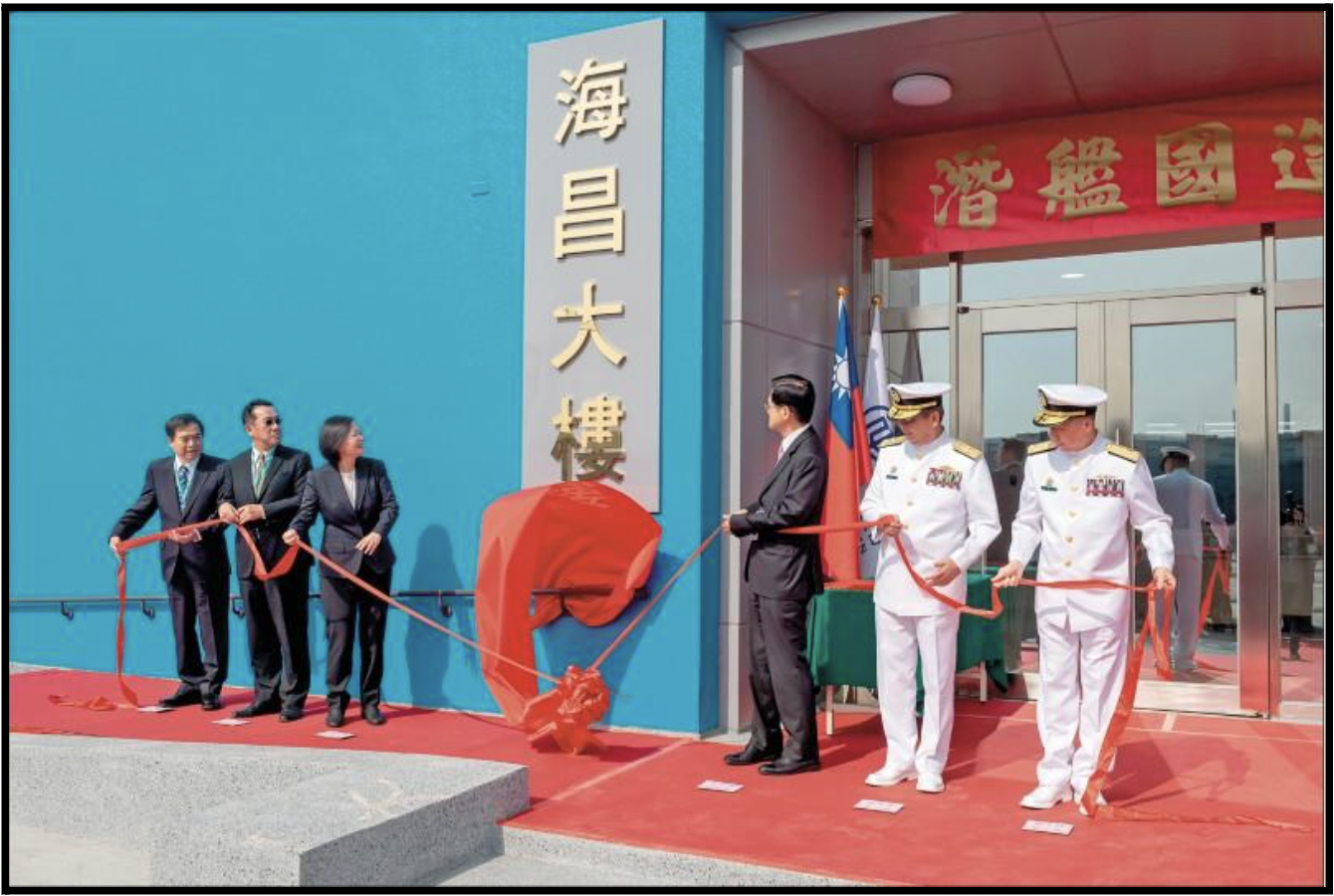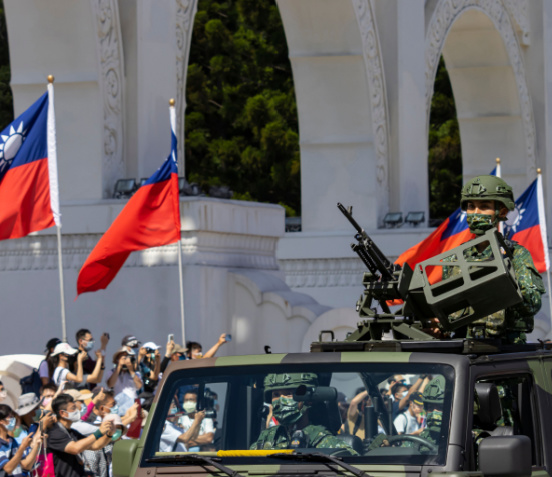The acquisition of a fleet of more modern submarines for the Republic of China Navy (ROCN) has long been one of the highest-priority—and sometimes controversial—defense acquisition programs for Taiwan’s armed forces. For many years, the ROCN has fielded only two effective operational submarines, both of the venerable Hai Lung (海龍) class. [1] Based on the Dutch Zwaardvis class, these two submarines were constructed in the Netherlands and delivered to Taiwan in the late 1980s. After more than three decades, these vessels are past their standard service life, and obsolete in the face of the more modern submarines being fielded by navies in the Indo-Pacific region—particularly those operated by the rapidly advancing submarine force of China’s People’s Liberation Army Navy (PLAN).
In the intervening decades since the two Hai Lung acquisitions, Taiwan’s Ministry of National Defense (MND, 中華民國國防部) explored a number of options for foreign submarine purchases, none of which ever came to fruition. In terms of foreign acquisition, the fundamental problem for Taiwan has been that European defense contractors, who in the 1980s and early 1990s were more willing to sell advanced weapons systems to Taiwan (such as the 1992 sale of French Mirage fighter jets), have become increasingly subject to pressure levied by the People’s Republic of China (PRC). As a result, the United States has increasingly become the only advanced weapons manufacturing country still willing to supply defense systems to Taiwan.
However, the US Navy submarine fleet currently consists entirely of nuclear-powered vessels, and the US naval shipbuilding industry therefore lacks the infrastructure and experience to produce diesel-electric submarines. [2] While nuclear power confers substantial advantages to submarines, such a program is far more expensive than a diesel program, and further requires an extensive personnel training and qualification pipeline—as well as butting up against political controversies regarding the mooring of active nuclear reactors near densely populated port facility areas.
Furthermore, Taiwan’s defense needs—namely, for a more modern submarine platform capable of effective local sea-area operations, without significant concerns for longer-range patrols or at-sea endurance—point more in the direction of conventional, diesel-electric propulsion. With no foreign manufacturer willing to sell Taiwan diesel submarines, and the United States being incapable of doing so, Taiwan’s defense policymakers have increasingly turned toward the creation of an indigenous manufacturing program in recent years, despite the attendant start-up costs.

Image: A model of Taiwan’s planned indigenous submarine class on display at Taiwan CSBC Corporation in Kaohsiung, May 2019. (Image source: CNA)
Taiwan’s Indigenous Submarine Construction Program
Taiwan’s Indigenous Defense Submarine (IDS, 自製防禦潛艦) program, also referred to as the “Hai Chang Program” (海昌計畫), was launched in 2016. The program included plans to produce a total of eight vessels, with the first vessel scheduled to be completed by 2025. It was reported in 2017 that the design phase of the project would cost NTD $2 billion (approximately USD $65.4 million), but the overall costs for actual construction of the eight boats will be orders of magnitude higher. Officials from Taiwan CSBC (台灣國際造船股份有限公司), the Kaohsiung-based lead manufacturer for the vessels, have previously indicated that the prototype vessel would cost NTD $49.3 billion (approximately USD $1.6 billion), and take about five years to build.
Although the design details for the IDS have not been made public, it is believed to be a composite design, with some observers noting that public models of the IDS resemble the Soryu-class submarine in service with the Japanese Maritime Self-Defense Force (JMSDF), particularly in terms of the “X”-shaped stern end of the hull. Taiwan CSBC officials have indicated that the planned prototype will have approximate dimensions of 8 meters wide and 18 meters high, with a length of 70 meters and a displacement weight between 2,500 to 3,000 tons. Naval engineers and former submarine personnel from multiple countries—including the United Kingdom, South Korea, India, and Japan—have reportedly been recruited to assist with the program. In addition to Taiwan CSBC, other institutions in Taiwan reportedly involved with the IDS program include the Naval Shipbuilding Development Center, the ROCN 256th Submarine Squadron, and the Chungshan Institute of Science and Technology (國家中山科學研究院).
While many aspects of the IDS program remain shielded from public view, the Tsai Ing-wen (蔡英文) Administration has sought to give the program significant exposure for public relations purposes, promoting it as another example of a major initiative taken to improve Taiwan’s defense capabilities. Since the announcement of the program, Tsai has made publicity trips during her tenure to visit the ROCN’s existing submarines and their crews, and appeared alongside senior ROCN and defense officials at the November 2020 ribbon-cutting ceremony held to officially open the CSBC administration building from which the IDS program would be managed. Personnel from the ROCN’s 256th Submarine Squadron are reportedly working in tandem with Taiwan CSBC officials at the Kaohsiung shipyard facility to supervise the project towards completion.

Image: Taiwan President Tsai Ing-wen (third from left), along with civilian officials and senior ROC Navy officers, at a November 2020 ribbon-cutting ceremony held at a Taiwan CSBC facility in Kaoshiung to mark the official opening of the IDS program administration building. (Image source: Liberty Times)
The US Role in Taiwan’s Indigenous Submarine Program
The United States has played at least a limited supporting role in providing the IDS project with US-designed submarine technology. In spring 2018, the Trump Administration reportedly approved an export license to US defense contractors to provide submarine technology to Taiwan—without further public disclosure as to what, specifically, those systems might be. In May 2020, the Defense Security Cooperation Agency (DSCA) announced the sale of eighteen MK-48 Mod6 Advanced Technology (AT) Heavy Weight Torpedoes (HWT) and associated equipment (for an estimated cost of USD $180 million). In December 2020, the US approved the sale of an unspecified digital sonar system to Taiwan, presumably intended for the IDS project.
This process has continued under the Biden Administration: in March 2021, comments by ROC Defense Minister Chiu Kuo-cheng (邱國正) indicated that the United States had approved export permits for further submarine technology sales to Taiwan. These systems were not identified, but MND officials have reportedly signaled that their primary acquisition interests are for digital sonar systems, combat management systems, and periscopes. The lack of specificity regarding the systems (or designs) transferred likely reflects continuing sensitivities regarding the operational security of the IDS program, and the imperative to keep from public disclosure the specific expected capabilities of the IDS boats.
Taiwan’s MND Announces Benchmarks for 2023
Public policy discussions regarding the IDS program have reemerged into public view over the past year, as the program has moved nearer to producing the first functional prototype. In July 2022, Executive Yuan (EY, 行政院) officials indicated that the program was on track, and further indicated future intent to budget NTD $300 billion (USD $9.78 billion) for the procurement of seven additional boats, to round out the projected eight. (Design and manufacturing costs will always be highest for the initial unit in any new naval class, with per-unit construction costs expected to decline as production of subsequent units continues.)
Taiwan press reporting from January of this year indicated that six sections of the vessel’s hull had been completed, with only the topmost sail section (i.e., the section containing the raised conning tower) remaining to be finished. On May 10, Taiwan CSBC Chairman Cheng Wen-lon (鄭文隆) stated at a press conference that the prototype IDS vessel would be ready for final testing in September of this year (although it was unclear in this context what, exactly, final testing might mean). [3] Cheng indicated that Taiwan had obtained 107 unspecified technologies from abroad to aid in constructing the submarine, but that his company’s shipyard had manufactured many of the ship’s key components: including airtight doors, hydraulic systems, a water filtration system, and a silent air-conditioning system.
Conclusions
The announced September timeframe of testing certifications for Taiwan’s initial IDS unit—whatever that “final testing” might mean in specific terms—could mark a potential major milestone in terms of both Taiwan’s indigenous defense production, and its future defense posture. Taiwan’s indigenous naval shipbuilding programs have demonstrated significant advances in recent years in terms of producing lighter surface combatants, such as the Tuo Chiang (沱江) class of guided-missile patrol craft (PGGs) catamarans. If the initial IDS prototype unit is indeed on track, as government and Taiwan CSBC officials have indicated, it would represent a significant success in a technically challenging endeavor—and one in which Taiwan’s shipbuilding industry possessed no previous experience or institutional expertise.
Many questions remain, however. The production of a total of eight platforms is an ambitious undertaking, and it remains to be seen what the timeline would look like for Taiwan’s existing naval shipbuilding infrastructure to produce the full series of vessels (especially alongside competing production capacity and budgetary requirements for indigenous surface ship construction). There also remain open questions regarding the crew training and certification programs for a dramatically expanded submarine branch of the ROCN, as well as implementation of the procedures for the potential deconfliction of both peacetime and wartime patrol areas with allied and regional countries.
The biggest questions, however, may be the larger questions as to how a force of more modern diesel-electric submarines would fit into Taiwan’s overall defense strategy. The existence of such a submarine force—particularly one built with Taiwan’s own engineering know-how, albeit with considerable foreign assistance—would carry with it a certain amount of prestige, as well as an undeniable level of deterrent value against a naval aggressor. Yet there are a variety of potential operational models for a submarine force to follow: ranging from Nazi Germany’s commerce-hunting “wolfpacks;” to the US Navy’s controversial 1980s “Maritime Strategy” of challenging the Soviet Navy in its bastion areas; [4] to a more passive posture of a submarine “fleet in being” intended to complicate the work of PLA planners contemplating either a blockade or invasion of Taiwan. Working out the underlying strategy and operational concepts for a submarine force could prove to be just as complicated, if not more so, than producing the submarines in the first place.
The main point: Taiwan shipbuilding industry officials have announced that the prototype unit of Taiwan’s “Indigenous Submarine Program” (IDS) will complete basic construction by September of this year. The construction of such a vessel—the first of a reported series of eight diesel-electric submarines intended for service with Taiwan’s navy—would represent a major success for Taiwan’s indigenous naval shipbuilding industry. It would also raise many questions regarding the underlying defense strategy and operational concepts connected to how such a force of submarines would be employed.
[1] The ROCN also has in its order-of-battle the Hai Shih (海獅, “Sea Lion”) a Guppy-class submarine—which is based on World War II-era designs, and is over 70 years old. The vessel reportedly underwent limited upgrades in 2017 intended to extend its service as a training vessel. However, this antiquated vessel is unlikely to be a deployable unit fit for either peacetime patrols or wartime service.
[2] The last diesel-electric boats operated by the US Navy, the Barbel-class submarines, were built in the late 1950s and decommissioned by the late 1980s.
[3] US naval vessels, for example, will pass through multiple certification processes before entering active service, to include: certification of the completion of construction, also involving a “pre-commissioning” status during later stages of construction; a “commissioning” of the unit into the service’s active vessel inventory; and “sea trials” during the early stage of service, to confirm the vessel’s seaworthiness and operability of its systems, and to train the crew. It is unclear what the September 2023 “final testing” for the IDS prototype will be, but it is presumably a benchmark for the completion of basic unit construction and systems installations.
[4] Christopher A. Ford and David A. Rosenberg, “The Naval Intelligence Underpinnings of Reagan’s Maritime Strategy,” The Journal of Strategic Studies 28, no. 2, April 2005.





